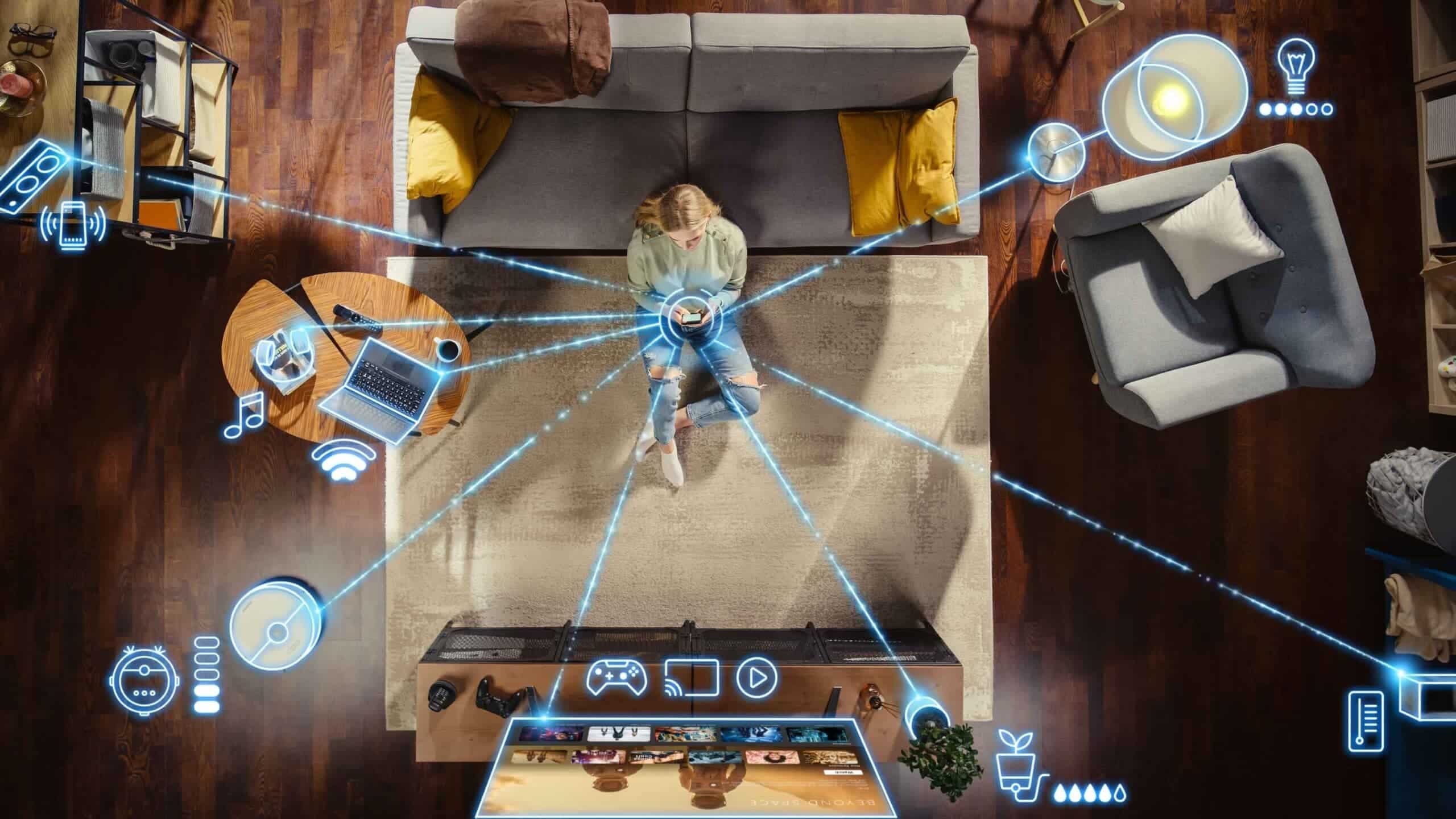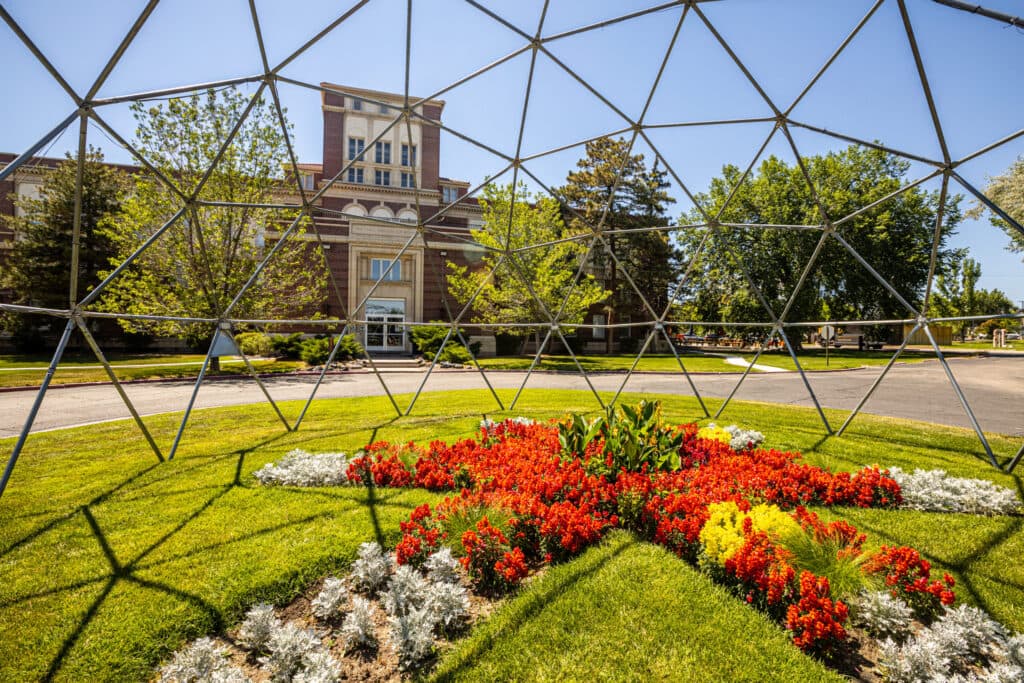Current interior design trends emphasize more than just the aesthetics of space; they highlight the potential of smart home technology. From home automation systems to new lighting solutions, smart technology is playing an increasingly prevalent role in interior design plans. As such, aspiring interior designers need to be aware of the latest smart home trends.
Understanding Smart Home Technology
Modern home automation relies on smart home technology. This type of technology is often described as intuitive and efficient, and most smart devices can be connected create a comprehensive home automation system.
On the surface, smart home technology seems like a separate component of home design, but in fact, it plays an integral role in today’s most modern and advanced interior design strategies.
What Is Smart Home Technology?
According to an article published in the Renewable and Sustainable Energy Reviews journal, smart home technology is defined as any internet-connected device that can be automated to adjust to the user’s habits and lifestyle while simultaneously streamlining efficiency within the home. Another hallmark of smart home technology is that these devices can be controlled by users remotely, giving them the power to adjust the settings within their home even while they are away. Wireless home control continues to be one of the most appealing facets of smart home technology, particularly for those who want to prioritize sustainability within their home.
The Role of Smart Technology in Interior Design
The International Interior Design Association defines interior design as the professional approach to creating a space that meets the needs of the individuals who utilize it. Within the context of this definition, smart technology plays a central role in the interior design trends and strategies of today. By prioritizing connected home design, interior designers can create a space that is not only beautiful but also functional and convenient, giving their clients the unprecedented results that they crave.
Integrating Smart Technology Into Interior Design
Weaving smart technology into your interior design plans allows you to provide clients with a centralized control system that improves the efficiency of the space, all while giving them a more convenient and comfortable place to enjoy. Whether you are working to create a home office for a client or are designing bedrooms for your home, awareness of the latest smart home trends can help you effortlessly incorporate them into your interior design strategy.
These are some of the most critical components of home automation design:
Smart Lighting Solutions
The American Society of Interior Designers stated in 2022 that most homes would have between two and three smart devices in the coming years, with smart lighting solutions being some of the most sought-after devices among tech-savvy homeowners. Smart lighting solutions include wireless lighting devices that can be controlled remotely, eliminating the worry of forgetting to turn off the lights when they leave the room or even the house. According to Energy Star, there is a wide range of smart lighting technology available, including lights that will turn off automatically, lights that can be controlled from an app on a wireless device, and lights that can be paired with other smart devices (such as digital home security devices).
Smart Climate Control and Energy Management
Smart thermostats and other climate control devices are crucial components of any home automation system. For many homeowners, these devices were the first smart devices they invested in. With a smart thermostat, homeowners can control their settings remotely, giving them the ability to reduce their energy usage and lower their utility costs. In addition, most smart thermostats and other climate control devices will begin to learn the habits of the residents and automatically adjust their settings accordingly. These devices are one of the best ways to prioritize smart home energy management.
Smart Home Security and Surveillance
Smart home security is increasingly prevalent in interior home design, particularly as these devices become more effective and responsive. Security cameras and surveillance technology can now be easily incorporated into any room, as these devices are often small and discreet. The goal of smart home security and surveillance is to provide the homeowner with confidence and peace of mind. Interior designers often work to incorporate security technology into their design plans.
Designing for a Seamless Smart Home Experience
As an interior designer, you can provide your clients with exceptional results by designing with a seamless smart home experience in mind. By embedding technology into your plan and prioritizing home automation trends, you can give them a space that is beautiful, functional, and efficient.
You can enact tech-driven interior design by:
Creating a Centralized Control Hub
A centralized control system is essential to any tech-enabled interior design plan, as the people living and working in the space will need to easily control the devices in their homes. According to an article published in Designers Today, the American Society of Interior Designers notes that the rising number of people working in hybrid roles has increased the need for smart home design, and a centralized control hub allows residents to effortlessly navigate their personal and professional responsibilities from the comfort of their home.
Blending Technology With Aesthetics
While smart devices continue to be in demand among interior design clients, many designers often have to navigate the challenges associated with blending tech with aesthetics. The bottom line is, the technology that you embed into your interior design plan cannot compromise the appearance of the space. This requires designers to find precise and discrete devices that will enhance the appearance of the room while simultaneously increasing its functionality. In some cases, you will work to hide smart devices in plain sight, such as when you incorporate an interactive interface into the design of a kitchen. In other cases, you may use decorative elements that hide devices, like using a vase to hide a smart home assistant device.
Future-Proofing Your Design
Perhaps one of the biggest problems with accommodating the latest smart home trends is that most trends will continue to evolve. By recognizing emerging trends and developing a versatile interior design plan, you can future-proof your design to incorporate innovative technology that has yet to be released.
Case Studies: Successful Integration of Smart Technology in Interior Design
As an aspiring interior designer, you may wish to explore case studies that highlight the powerful role smart technology can play in interior design. It’s important to recognize that smart technology does not necessarily have to be reserved exclusively for luxury homes.
Analyzing Real-World Examples
These are a few jaw-dropping examples of how smart technology can enhance interior design:
- The Edge in Amsterdam, Netherlands – Described by Bloomberg as the smartest building in the world, The Edge streamlines efficiency by using a sophisticated sensor and app system that tracks everything from lighting to temperature, adjusting these elements based on occupancy and natural light to reduce energy consumption and enhance user comfort.
- Songdo International Business District in Incheon, South Korea – This business district was constructed from the ground up with technology and sustainability in mind. It even features residential housing with trash tubes that automatically collect and sort garbage from recyclables.
- Bill Gates’ Smart Mansion (Xanadu 2.0) in Medina, Washington, USA – Recently placed on the market, Realtor.com notes that this home has incredible smart features, including remote blinds and radiant heat flooring.
Interviews With Interior Designers
Here are a couple of leading contemporary interior designers’ thoughts and philosophies on home technology trends:
- Kelly Hoppen (UK-based interior designer), in an interview with the British Institute of Interior Design – ” My design philosophy revolves around simplicity, comfort, and balance. I aim to create spaces that are not only visually appealing but also functional and comfortable for everyday living. It’s about combining the luxurious with the practical, using a mix of textures, clean lines, and neutral tones to achieve a timeless and elegant look.”
- Shalini Misra (India-born, London-based interior designer), in an interview with the British Institute of Interior Design – “Ultimately, the space that you are creating is for someone to love, to be inspired by — quite literally a launch pad from which they go on to live their lives in the outside world. That space must be imbued with a sense of well-being that resonates with that person’s spirit. So I try to put designs together for people that feature sustainable materials, timeless elegance, and enduring versatility so they have the potential to last for many years rather than just a few seasons.”
The Benefits and Challenges of Smart Home Integration
Smart home technology is new and exciting but designers must weigh the benefits and challenges associated with smart home integration. By being aware of both the benefits and drawbacks of home automation systems, interior designers can make personalized choices based on the needs of their clients and emerging industry trends.
Enhancing Comfort and Convenience
Ultimately, smart technology in home design serves to improve the comfort and convenience of the space, which is paramount when working with residential clients. Interior designers can continue to leverage smart technology and AI-enabled devices to provide clients with an experience-driven design concept that allows for customizable options within the environment. As a result, technology is expected to continue to play a prominent role in interior home design in the months and years to come.
Addressing Common Challenges
However, there are some obstacles to keep in mind when it comes to utilizing smart devices in interior design. According to the Home Technology Association, a couple of common challenges include:
- Misunderstanding the needs and desires of the client.
- Aligning available technology with the client’s budget.
By making an effort to discuss technology before you begin to draft the interior design plan, you may avoid these issues and develop a seamless plan in line with the expectations of your client.
Explore Futuristic Interior Design Styles at Rocky Mountain College of Art + Design
At Rocky Mountain College of Art + Design, we recognize the power of smart home interior design, which is why we incorporate futuristic interior design strategies into our program curriculum. With both an on-campus Bachelor of Fine Arts in Interior Design and online Bachelor of Fine Arts in Interior Design degree, these programs allow students to develop the skills needed to pursue a creative and rewarding career in this growing field. Request more information about our interior design degree programs today.

